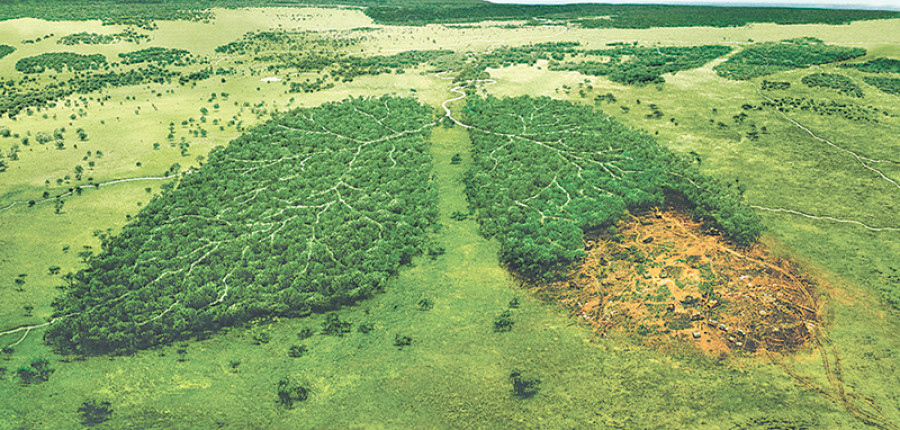Opinion
REDD signals
Deforestation and forest land degradation contribute to 17 percent of worldwide carbon emissions, which in turn has a considerable impact on the current global warming phenomenon.
Aditya Acharya & Mahesh Poudel
Deforestation and forest land degradation contribute to 17 percent of worldwide carbon emissions, which in turn has a considerable impact on the current global warming phenomenon. So, reducing emissions that arise as a result of deforestation and forest degradation was seen as a means to address this phenomenon. Initially conceived as RED (reducing emissions from deforestation in developing countries), the current state of REDD+ was formalised during the 13th Conference of Parties (COP) to the United Nations Framework Convention on Climate Change (UNFCCC) in Bali, Indonesia in 2007. The concept is to allow the developed countries (Annex 1 countries of the UNFCCC) to offset their emissions by providing financial incentives for the projects in developing countries (non-Annex 1 countries of the UNFCCC) that reduce emissions by preventing deforestation and degradation.
The formal term now is REDD+ which is an extension of REDD (reducing emissions from deforestation and forest land degradation) through the addition of three other components: forest conservation, sustainable management of forests and enhancement of forest carbon stocks. REDD is the mechanism to curb emissions and UN-REDD is the programme of the United Nations (UN) that assists participating countries in achieving REDD readiness. The UN-REDD program has 64 partner countries; 28 in Africa, 19 in Asia Pacific and 17 in Latin America and the Caribbean.
Worth more cut down
Transparency International (TI) last month (February) published the Corruption Perceptions Index (CPI) report for 2017 that shows the perceived level of public sector corruption in 180 countries around the world. Of the 64 partner countries of the UN-REDD program, 57 (89 percent) of them have a CPI score of less than 50 out of 100—zero being the most corrupt and 100 the cleanest. Fifty five out of those 64 (86 percent) have a CPI score of less than the global average score of 43.07. Only five (7.8 percent) of them have a CPI score of more than 43.07 and four of them are not scored. Bhutan and Chile are the least corrupt countries among those 64 countries with an equal score of 67 while Costa Rica is second. Can we really be optimistic about the success of a mechanism that is supposed to work among the most corrupt countries of the world? Is carbon finance fair and effective? Transparency writes: “Sadly, many of the world’s most densely forested countries have a poor track record for corruption. In the current global economy, trees are worth a lot more cut down than they are in the ground, and politicians have been known to accept bribes—sometimes huge—to grant companies access to forest zones that should be protected.”
There are seven safeguards which were adopted at COP 16 in 2010 in Cancun, Mexico (hence called Cancun safeguards) keeping in mind the potential risks that might arise during the REDD implementation, which also includes “transparent and effective national forest governance structures, taking into account national legislation and sovereignty”. But these countries are corrupt not because they don’t have good laws and policies, but because of the corrupt bureaucracy and politicians. If a country fails to meet the safeguards, the regulation stipulates that they will not be paid. However, billions of dollars have already been invested in said nations to ready them for REDD implementation. Was all that money wasted? To add to the problems, the indigenous people of these countries, where the literacy percentage is also very low, are expected to fully trust the corrupt bureaucracy in their countries to deliver them the benefits of keeping the forests safe.
Future steps
Moreover, how does REDD benefit the environment if developing countries curb their emissions of greenhouse gases (GHGs) but developed countries emit an amount of emissions equal to those that developing countries cut back on, and are allowed to do so because they pay the developing countries money. Alternative ways of reducing the emissions should be sought. The developing countries should attempt to pressure the developed ones to reduce their carbon emissions, rather than asking for payments.
Either money that is going to the developing countries should be invested in the developed countries themselves so they reduce emissions, or the corruption in the developing countries should be highly reduced. Otherwise, there are no green signals for REDD.
Acharya is natural resource management officer at PolCom Research Center, Kathmandu; Poudel is assistant forest officer, Department of Forests, Government of Nepal




 8.12°C Kathmandu
8.12°C Kathmandu











